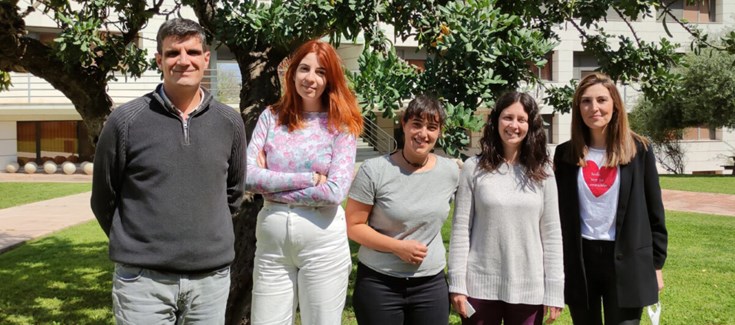They are studying how stress during adolescence affects the thalamus, an area of the brain affected in mental illnesses such as depression or schizophrenia.

From left to right: Juan Nacker, Julia Alcaide, Clara Bueno, Martha Perez and Esther Castillo.

INCLIVA | Thursday, October 10, 2024
Several groups from the Mental Health Unit of CIBER (CIBERSAM), the Health Research Institute INCLIVA, the University Teaching Hospital of Valencia and the University of Valencia (UV) have described how stress during adolescence alters behavior and brain function. an area of the brain necessary for processing information coming from the outside, and also involved in complex cognitive processes. The study was recently published in the journal Neurobiology of diseases.
Juan Najer, principal investigator of CIBERSAM, coordinator of the research group Psychiatry and Neurodegenerative Diseases INCLIVA, professor of cell biology at UF, author responsible for the article, explains that “The thalamus is a very interesting area because it has been seen to be affected in various mental illnesses such as depression or schizophrenia, and our own work with neuroimaging of patients shows that this is indeed the case. In the current study, we fundamentally dissect inhibitory neuronal circuits that are fundamental to the control of thalamic function and demonstrate in mice that adverse experiences during adolescence have very important effects on the thalamus, especially in women.“
Increasing knowledge about mental illness, especially depression and schizophrenia, is the main goal of the INCLIVA Psychiatry and Neurodegenerative Diseases Research Group. “These are very common diseases, affecting more than 1% and 5% of the world population, respectively. These are serious diseases that are still poorly understood and pose a great burden to both the patient and those around him.“, explains Naeher.
New therapeutic mechanisms
The work also explores new therapeutic mechanisms that may help reduce symptoms and improve patients’ lives. TOis currently specifically studying the impact that adverse experiences in early life (childhood and adolescence) may have on the development of depression and psychosis in adulthood, from an interdisciplinary perspective, using animal models, post-mortem patient tissue, neuroimaging, genetics and psychological assessments.
In addition, the study also explores new diagnostic procedures that provide direct or indirect access to patients’ brains, both through neuroimaging analysis and by studying genes and molecules in the blood, through olfactory epithelial cells that share many characteristics. with neurons or by forming neuronal lines from blood cells. The group is also involved in initiatives to promote suicide prevention and develop strategies to reduce its incidence.
The group’s research typically uses platforms such as the INCLIVA precision medicine facility, as well as scientific and technical equipment from both INCLIVA and UV. The group, which is part of INCLIVA’s cross-cutting programs on rare diseases and neurological disorders, maintains active national and international collaborations to develop ongoing projects.
He currently has ongoing projects from the Carlos III Institute of Health, the Ministry of Science, Innovation and Universities, the Generalitat of Valencia (Prometeo Programme), the VLC-Bioclinica program and the Alicia Koplowitz and Mutua Madrileña Foundations.
Product link:
Alcaide, J., Gramuntel, Y., Klimczak, P., Bueno-Fernandez, C., Garcia-Verellen, E., Guicciardini, C., Sandi, C., Castillo-Gomez, E., Crespo, C., Perez-Rando, M., and Nacker, J. (2024). Long-term effects of peripubertal stress on the reticular nucleus of the thalamus in female and male mice. Neurobiology of diseases 200106642. https://doi.org/10.1016/j.nd.2024.106642.
